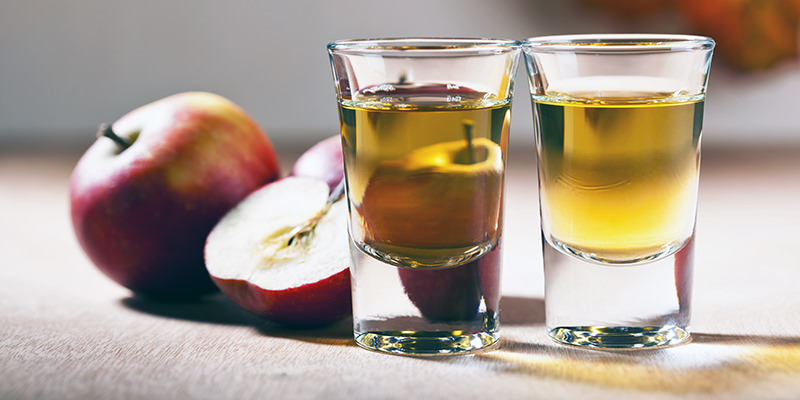Taking for granted the slew of cultural distortions already embedded in the holiday, and bringing none of those up (because Uncle Reggie’s had a few), here’s a fun holiday quiz: this Thanksgiving, ask your assembled friends and family, “What’s the most American thing to drink on Thanksgiving?” One person will sit back in his rocking chair, take a sip of bourbon, and whisper “Sweet, sweet Pappy.” Somebody else is bound to shout, “Budweiser, you communist!” and start slurring through the Pledge, while forgetting Bud’s massive debt to classic German lager. And at least one beleaguered relative will say “Anything, sweetie, because that’s what you need to get through,” and then pour another glass of White Zinfandel.
They’re all right, a little bit, but if we’re being technical, and finicky (it’s the holidays), the most American thing to drink on Thanksgiving is Applejack. Laird’s, to be precise.
This isn’t brand pushing. It’s history, through the eyes of one brand, a brand that’s been arm in arm with America from its earliest, squeaky days as a baby country through the Civil War and Prohibition and into the era of Kardashians, multiple Bush presidencies, and Deflategate. Other spirits and beers and alcoholic products might have a place in the sprawling American family tree, but Laird’s is grafted onto the roots: they began producing Applejack all the way back in 1698, and incorporated as the country’s first commercial distillery in 1780. Abraham Lincoln supposedly served Laird’s in his Springfield, Illinois, tavern (for 12 ½ cents a pint). A Laird served in the Revolutionary War under George Washington. And, oh yeah, only one other person was ever given the family recipe. And that dude was Washington.
But the real reason Laird’s is so thoroughly American isn’t just because they were the first distillery in the nation as a nation. It’s because Laird’s was one of the first instances of the American dream kind of come true, even though, yes, they did end up in Jersey.
Like many before him and many to follow, William Laird immigrated to Monmouth County, New Jersey, from Scotland in the late 17th century. Apples just so happened to grow really well in the States (cider is really America’s quintessential beverage). In fact, the earliest settlers (i.e. the guys who got lost on their way to Virginia and landed in Plymouth Rock) had actually brought apple seeds with them, and those orchards were among the first cultivated in the New World. Not long after he landed, Laird started producing Applejack—an apple brandy made by distilling fermented apple juice—and a family legacy was born.
The America-ness doesn’t end with successful immigration, Pilgrim-planted apple orchards, or even the establishment of a family-owned business that’s lasted over 300 years (the ninth generation is now at the helm). There’s horse racing, too. Descendant Joseph Tilton Laird actually moonlighted as a racehorse trainer (imagine the psychological toll/advantage of dividing your time between brandy distilling and the track). Apparently, Laird was a good trainer—the family horse, Fashion, helped Joe Laird amass enough money to buy a larger distillery in Scobeyville, New Jersey—and that remains Laird’s headquarters to this day.
Prohibition, of course, proved a slightly awkward time for Laird’s, but they got by, first producing apple juice, and then, in 1931, John Evans Laird got permission to produce apple brandy for “medicinal purposes” (yes, back in the day, you could get a prescription for hooch).
So what is Applejack, exactly? Apple brandy, though it’s gone through some changes. Once called “Jersey Lightning,” the older iteration of the recipe was a bit rougher around the edges than what you’ll find in a bottle today, not least because old school distilling didn’t have nearly as many technical measurements available. Today, what you’ll get in a bottle of Laird’s Applejack isn’t straight apple brandy, but a mixture of 35% apple brandy with 65% neutral spirits, essentially “lengthening” the brandy flavors so they’re slightly less concentrated but smoother, and still round with fruit. Laird’s also produces straight brandies, barrel-aged either 7 ½ years or 12 years (a small number of barrels every season are deemed worthy of aging). And while they may not produce it, Laird’s even has its hands in the bourbon and rum industries. But if you’re going to plonk anything down on the holiday table and say “Behold, the spirit of the nation!,” make it Applejack. And wear one of those Pilgrim hats, just ‘cause.

